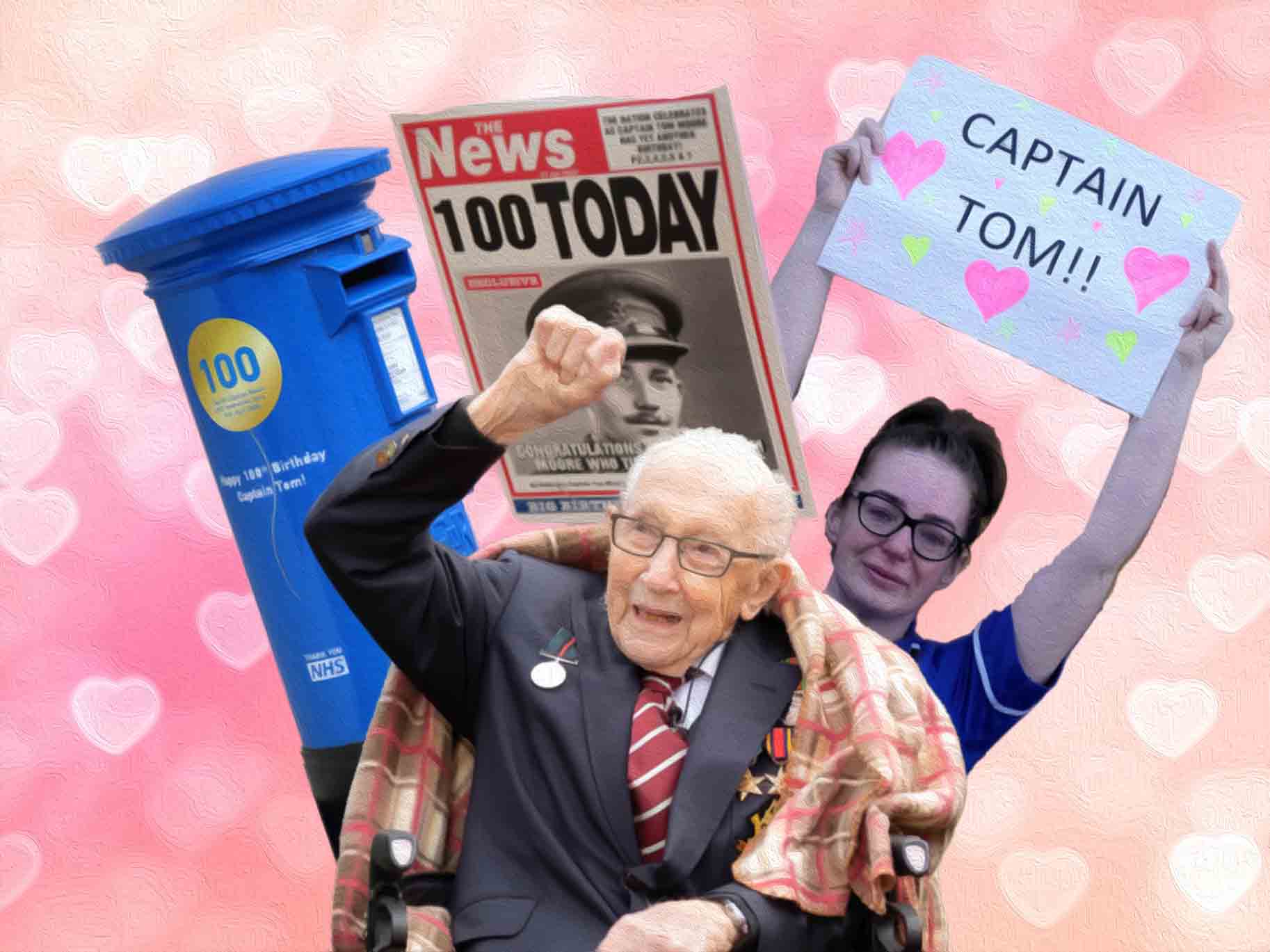The Independent's journalism is supported by our readers. When you purchase through links on our site, we may earn commission.
Captain Sir Tom Moore: How a war hero became the face of Britain’s pandemic spirit
From Bedfordshire veteran to national treasure in under a month, Captain Tom became the face of resilience from his back garden, writes Sophie Gallagher


Your support helps us to tell the story
From reproductive rights to climate change to Big Tech, The Independent is on the ground when the story is developing. Whether it's investigating the financials of Elon Musk's pro-Trump PAC or producing our latest documentary, 'The A Word', which shines a light on the American women fighting for reproductive rights, we know how important it is to parse out the facts from the messaging.
At such a critical moment in US history, we need reporters on the ground. Your donation allows us to keep sending journalists to speak to both sides of the story.
The Independent is trusted by Americans across the entire political spectrum. And unlike many other quality news outlets, we choose not to lock Americans out of our reporting and analysis with paywalls. We believe quality journalism should be available to everyone, paid for by those who can afford it.
Your support makes all the difference.On Monday 6 April 2020 – exactly two weeks after Boris Johnson told England it was going into an unprecedented national lockdown – most of us were licking our wounds with banana bread and Zoom quizzes. But at a family home in Bedfordshire, 99-year-old Captain Tom Moore had decided, with the help of a walking frame, to start pacing 25-metre lengths of his back garden, 10 times a day, in a bid to raise money for NHS Charities Together. His goal: a modest £1,000.
Just 24 days later, on his 100th birthday, Captain Tom had raised well over £32m, (estimated to be closer to £40m with gift aid rebates) crowdsourced from approximately 1.5 million individual donations. Fundraising is nothing new – UK platform JustGiving has collected well over £4bn in donations since its launch in 2000 – but this particular endeavour saw a former war veteran, known only to his family and local community, become a household name. Captain Tom successfully captured the zeitgeist of that first lockdown. The Blitz pandemic spirit.
Read more: Queen pays tribute to Captain Tom Moore
The impact of Captain Tom’s effort, on the media and popular culture in the first half of 2020, cannot be overstated. He was given an RAF flypast; awarded a gold Blue Peter badge; named GQ magazine’s “inspiration of the year”; made an honorary colonel and honorary doctorate; given a Pride of Britain award; became the first member of the FA’s Lionhearts squad (after a special visit from David Beckham no less); had a number one single with Michael Ball; smashed two Guinness World Records; launched a gin range; was unveiled as a new portrait at the National Army Museum; and drew Her Majesty out of isolation for a knighthood ceremony at Windsor.
And it wasn’t just top-level media spin on a clickbait story of charity – Captain Tom seemed to resonate with people at a grassroots level too. He was sent 150,000 birthday cards from across Britain (so many in fact the Royal Mail had to set up a dedicated sorting facility); gathered 349,000 followers on Twitter; was depicted in murals in Cambourne, Tamworth and Thetford; had everything from fleets of buses, trains, and powerboats, to a West Midlands police dog named after him. A toy train designed by Hornby Railways and named the Capt Tom Moore, sold a record 3,500 units in four days – averaging one every two minutes and 26 seconds.
A poll of 2,000 Brits saw his charity walk named as the highlight of the first lockdown. Beyond a reduction in pollution and a new appreciation for key workers.
But why did Captain Tom’s efforts stand out in the crowd and capture the imagination of a nation in a time of crisis? How did he manage to capture the hearts and minds of people being inundated with day after day of bad news?
Captain Sir Thomas Moore was born on 30 April 1920, in Keighley, Yorkshire. He served as an officer in the British army, spending the Second World War in India and Burma (now Myanmar), where he ran a training programme for army motorcyclists. He also contracted dengue fever. After the war, he returned home to work in sales, in roofing and concrete. He was married twice (he divorced his first wife and remarried in 1968), had two daughters and several grandchildren.
He is a classic story… an ordinary person doing something unexpected
He was not only a war hero but an everyday, suburban, family man. His only former brush with fame was as a contestant on the 1983 Christmas Day edition of Blankety Blank with also beloved Terry Wogan. He was relatable (he had a great-nephew working as a junior doctor at a time when medical frontline workers were akin to war heroes), his stories endeared people to him (he joked about being caught speeding aged 98) but he was also particularly vulnerable; being nearly 100 years old and having just recovered from a fall-induced broken hip, rib and punctured lung before he started on his walk.
Dr Leora Hadas, assistant professor in culture at the University of Nottingham, with expertise in fan communities, tells The Independent we shouldn’t see Captain Tom as a surprising celebrity for our times but rather a classic example of an ordinary person doing something extraordinary. “In the sense that he is a classic story,” she says. “An ordinary or even disadvantaged person doing something unexpected, amazing, and highly emotionally touching. Remember Susan Boyle?”
Dr Hadas says Captain Tom presents “an effective story formula”. “It’s a story easy to whittle down to a quick punchy soundbite. Every single word from ‘army veteran’ to the nice round age figure [100], is packed with significance and emotion. Even the name, ‘Captain Tom’, has the ring of a fairytale character. His suit, medal, and walker combined make a great, instantly recognisable visual. He’s a ready brand.”
And his brand aligned closely with how the country was rebranding itself in April: millions of us volunteering in record numbers, clapping for carers on a Thursday evening and generating a sense of community. More than 5 million Brits volunteered for the first time in the lockdown. While traditional celebrities appeared increasingly out of touch by throwing lavish parties on private islands, people like Tom Moore, Marcus Rashford and Joe Wicks stepped into the void.
Captain Tom inspired many other people to take part in charitable activity: 100-year-old Dabirul Islam Choudhury raised £170,000 walking laps of his garden; 90-year-old Margaret Payne from Scotland vowed to climb the equivalent of a Highland mountain on her stairs for the NHS; six-year-old Frank Mills from Bristol with spina bifida raised £300,000; 10-year-old Max Woosey camped in his garden for the best part of nine months; a 16-year-old stroke survivor attempted to walk 100 laps on a treadmill after watching Captain Tom; and 70-year-old Mike Biggar, who had brain injuries after a car crash in 1992, walked 500 steps.
As well as channelling the Britain we wanted to see when we looked in the mirror, Captain Tom also represented something about our collective nostalgia for the past. Dr Robert Gutsche Jr, senior lecturer in critical digital media practice at Lancaster University, says: “[He] represents the steadfastness and resolute nature of contemporary British society in moments of crisis. His age is a testament to overcoming time and challenge withstanding, his war hero status among an ageing and dying breed of Brits serves as a symbol that ‘we can get through this’.”
Indeed, the subconscious (and often conscious) comparisons between former crises and the one we are currently living through, allow people to feel hope of a better future and triumph over adversity. Captain Tom knew this and crystallised the sentiment in his now much-cited catchphrase. “Tomorrow will be a good day,” he repeatedly told audiences watching BBC Breakfast, and Piers Morgan’s Life Stories. He also released a book of the same title.
Captain Tom also presents a specific societal fondness for having older people visible in the public eye, says Dr Gutsche Jr. “The spread of Captain Tom, specifically, garnered such support across generations, in part because of his presence in society at a time when the aged are shuttered away. Former US presidential candidate Bernie Sanders attracted cross-generational success, too, by taking questions of his age head-on, going out at the start of the last election campaign to hit baseballs and again shooting hoops in 2019.”
In a way, that a centenarian man would have to walk miles in his own yard to raise money isn’t a hope spot: it’s a tragedy
So it’s clear this type of story always appeals to people in times of crisis, but Dr Hadas says there is something specific about the Covid-19 pandemic keeping us online and feeding the story of Captain Tom and his contemporaries. “Passing on news through social media is something we all do to connect, and this is a great story to connect to others with,” she says. “It’s easily encapsulated and punchily emotional, which makes it very shareable and also completely uncontroversial: basically anyone would be happy to have it on their Facebook or Twitter feed.”
In fact, the success of Captain Tom’s popularity, both Dr Hadas and Dr Gutsche Jr say, means he was likely to be immune from any criticism, having transcended into “national treasure” status. In December, Moore took a family holiday to Barbados after British Airways paid for his flight. The trip came under some scrutiny in January when it was revealed Moore was being treated for coronavirus and pneumonia in hospital. On breakfast television, presenters Holly Willoughby and Phillip Schofield told trolls to “sod off” and Piers Morgan also came to his defence.
“In the end, Captain Tom isn’t likely falling from grace because of his Cummings-esque excursion, because in the British consciousness there aren’t many like him left,” says Dr Gutsche Jr.
In the future, to look back on Captain Tom to try to understand the British mindset in 2020 will perhaps be slightly misleading, says Dr Hadas. “These stories tend to be very much creatures of the moment. We celebrate these brief sparks of exceptional hope and goodness from individuals, but we aren’t great with thinking about long term, systemic social wellbeing – such as why the NHS needs to have private people fundraise for it. In a way, that a centenarian man would have to walk miles in his own yard to raise money isn’t a hope spot: it’s a tragedy.”
Whether Captain Tom’s achievement goes down in history as an example of the wider pandemic spirit or a rare example of an individual’s power to inspire hope is yet to be told, but there’s no doubt that for those of us who are living through it, Captain Tom was an unexpected hero, a celebrity when traditional celebrities seemed increasingly irrelevant. His death on 2 February will come as an emotional shock for many, even when taking into account his age and during a time when we have become all but accustomed to death on a grand scale.



Join our commenting forum
Join thought-provoking conversations, follow other Independent readers and see their replies
Comments